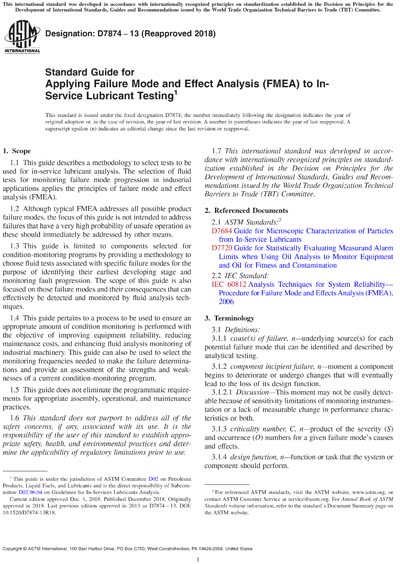Historical
ASTM D7874-13(2018)
Standard Guide for Applying Failure Mode and Effect Analysis (FMEA) to In-Service Lubricant Testing
1.1 This guide describes a methodology to select tests to be used for in-service lubricant analysis. The selection of fluid tests for monitoring failure mode progression in industrial applications applies the principles of failure mode and effect analysis (FMEA).
1.2 Although typical FMEA addresses all possible product failure modes, the focus of this guide is not intended to address failures that have a very high probability of unsafe operation as these should immediately be addressed by other means.
1.3 This guide is limited to components selected for condition-monitoring programs by providing a methodology to choose fluid tests associated with specific failure modes for the purpose of identifying their earliest developing stage and monitoring fault progression. The scope of this guide is also focused on those failure modes and their consequences that can effectively be detected and monitored by fluid analysis techniques.
1.4 This guide pertains to a process to be used to ensure an appropriate amount of condition monitoring is performed with the objective of improving equipment reliability, reducing maintenance costs, and enhancing fluid analysis monitoring of industrial machinery. This guide can also be used to select the monitoring frequencies needed to make the failure determinations and provide an assessment of the strengths and weaknesses of a current condition-monitoring program.
1.5 This guide does not eliminate the programmatic requirements for appropriate assembly, operational, and maintenance practices.
1.6 This standard does not purport to address all of the safety concerns, if any, associated with its use. It is the responsibility of the user of this standard to establish appropriate safety, health, and environmental practices and determine the applicability of regulatory limitations prior to use.
1.7 This international standard was developed in accordance with internationally recognized principles on standardization established in the Decision on Principles for the Development of International Standards, Guides and Recommendations issued by the World Trade Organization Technical Barriers to Trade (TBT) Committee.
ASTM International [astm]

